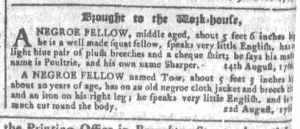GUEST CURATOR: Shannon Holleran
Who was the subject of an advertisement in a colonial American newspaper 250 years ago today?

“Brought to the Work-house, A NEGROE FELLOW, middle aged.”
This advertisement caught my attention because it is an advertisement about runaway slaves. After doing further research on runaway slaves, I discovered that advertisements like this were very common during this period. Advertisements similar to this one were used to recapture slaves and indentured servants. They listed specific physical characteristics, such as height and clothing. The abundance of slavery advertisements is why the Slavery Adverts 250 Project also exists. Slavery was such an important part of society and the colonists’ economy at this time that slavery advertisements were abundant in many eighteenth-century newspapers.
Sadly, according to Tom Costa, advertisements sometimes did not need to be posted because many slave owners would recapture their slaves within one to two weeks of their escape. Costa also states that many slave owners would only put out advertisements if the runaway was seen as valuable. Unfortunately, advertisements such as these often made it nearly impossible for slaves to escape to freedom.
Many slavery advertisements, spanning several decades, have been digitized and made available for the public to view in the Virginia Gazette. The Virginia Gazette is the only colonial and revolutionary-era newspaper that has been digitized and made available to the general public, providing the ability to view many advertisements similar to this one from the colonial and revolutionary eras. Also, other slavery advertisements are easy to view via the Slavery Adverts 250 Project. This project also provides the public with hundreds of slavery advertisements from 250 years ago, emphasizing how commonplace slavery advertisements were. The Slavery Adverts 250 Project includes slavery advertisements published in newspapers throughout all of the colonies.
**********
ADDITIONAL COMMENTARY: Carl Robert Keyes
As the guest curators from my Revolutionary America class and I work on this project together, we have many opportunities to discuss methodology, primary and secondary sources, and the availability of digitized documents to scholars and the general public. In the process, my students gain a better understanding of both the past and how historians pursue their work.
From now until the end of the semester, visitors to the Adverts 250 Project may notice that each student incorporates at least one advertisement concerning slavery into her or his week serving as guest curator. This complements the work that each will conduct when curating the companion Slavery Adverts 250 Project during a different week, giving each an opportunity to examine at least one slavery advertisement in greater detail.
Today, Shannon offers important observations about the accessibility of eighteenth-century newspapers, including the advertisements for slaves that prominently appeared in them. To complete their work on both the Adverts 250 Project and the Slavery Adverts 250 Project, students consult several databases of digitized newspapers as they draw material from the nearly two dozen published in the colonies in 1767. They complete most of their research using Readex’s Early American Newspapers, available via databases linked on the campus library’s website. That particular subscription, however, does not include all of the eighteenth-century newspapers Readex has digitized. When students visit the reading room at the American Antiquarian Society they have access to Readex’s America’s Historical Newspapers, which includes all of the newspapers available via Early American Newspapers as well as the Pennsylvania Gazette (perhaps the most important eighteenth-century American newspaper) and both versions of the Virginia Gazette published in 1767 (one by Purdie and Dixon and one by Rind). Students must also visit the American Antiquarian Society to access three newspapers printed in Charleston, South Carolina, via Accessible Archives.
As Shannon notes, it is not necessary to visit a research library or have remote access to their digital resources to examine the Virginia Gazette. Colonial Williamsburg has made these sources available to the general public via their Digital Library, which also includes manuscripts, research reports, and York County estate inventories. This collection of newspapers includes several publications (or continuations of publications with new printers) all published under the title Virginia Gazette: Parks (1736-1740, 1745-1746), Hunter (1751-1757, 1759, 1761), Royle (1762, 1763, 1765), Purdie and Dixon (1766-1774), Rind (1766-1774), Pinkney (1774-1776), Dixon and Hunter (1775-1778), Purdie (1775-1778), Clarkson and Davis (1779-1780), and Dixon and Nicholson (1779-1780).
The Adverts 250 Project includes a daily digest of all slavery advertisements published 250 years ago that day. The citations for advertisements from the Virginia Gazette always includes a link that takes readers to Colonial Williamsburg’s Digital Library, directly to the correct page of the newspaper so readers can examine each advertisement in its original context. Each advertisement tells an important story of human bondage, but they tell even richer and more complete stories when not disembodied from the other advertisements, news items, and other content that accompanied them. It’s not possible for the Adverts 250 Project or the Slavery Adverts 250 Project to provide that kind of access to every eighteenth-century newspaper. Colonial Williamsburg offers unique access to the Virginia Gazette to all readers, not just those associated with colleges and universities or major research institutions.
